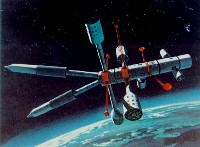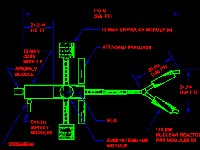Space Dock
Evidently the Space Dock is constructed from old rocket casings (as is the model, made using Airfix Saturn V rocket models). In 1969-70, NASA proposed to launch a very similar series of space stations derived from Saturn V third stages (the "S-IV-B", which had a diameter of 6.6 metres). By the mid-1970, the smaller station was to be replaced with a larger 10-metre station capable of housing 6-12 astronauts. It would have had the same diameter as the Saturn V "S-II" second stage, i.e. 10 metres and also serve as a habitation module on the Moon, Mars as well as in Earth orbit. These two modules are the basic "building blocks" of the Space:1999 Space Dock as well. Remarkably, the smaller S-IV-B station (later renamed Skylab) would have been launched in a "wet" configuration. After reaching orbit, the hydrogen fuel tank -- now empty -- would be converted into a two-storey accommodation for a three-man crew (the tank would have been equipped with windows, fittings for electrical equipment etc. before launch).



Since the Space Dock S-II and S-IV-B modules still have rocket engines attached, it would seem they too are empty rocket stages subsequently converted into habitation modules. Maybe it was assembled in the 1970s and early 80s to support the lunar colonisation effort. Notably, the 1970 NASA space station modules would have been able to function independently of each other so the modules could be combined into a large "space base" such as the 48-man versions depicted below by McDonnell Douglas and North American Rockwell. The outer sections are crew habitation modules and nuclear power generators while the central "spine" houses laboratories and logistics modules. Logically, the Space Dock contains similar facilities although the whole complex is considerably larger.
In addition to S-II and S-IV-B rocket stages, the Space Dock apparently contain a number of Apollo Service Modules docked to the end points of some of the S-II (habitation-?) modules. These could be small "space tugs" for moving payloads about in the vicinity of the Space Dock. Note the there are four small protrusions on the large centre section. These could be logistics modules (food,water,oxygen) that are periodically replaced with new ones from Earth or Moonbase Alpha.
The centre section of the Space Dock is much larger (16 to 18 metres diameter) so it was presumably added later and launched by an even bigger rocket than the Saturn V. In 1975-77 NASA briefly proposed to develop an even bigger, reusable Saturn V replacement to quickly and cheaply launch solar power satellite components. The three giant propulsion modules (utilising F-1 engines from the Saturn V first stage) visible at the base of the large core module as well as two of the S-II modules are perhaps the leftovers of such a rocket.
Due to the enormous size of the Space Dock, it was presumably assembled in low Earth orbit.The modules might initially have served as booster stages or in-orbit fuel depots before later being converted into habitation modules for scientists and space construction crews. As more efficient space propulsion systems became available in the 1980s, it would have been quite easy to move the facility to lunar orbit.
The tubular component construction closely resembles the real International Space Station being assembled in Earth orbit by a partnership of 16 nations beginning in 1998. However, the ISS modules are much smaller (4.5-metre diameter) and lighter since they had to be made compatible with the Space Shuttle after the Saturn V was cancelled in 1971.
Images copyright Martin Willey apart from Space 1999 images, copyright ITV Studios Global Entertainment. Thanks to Marcus Lindroos.
Page copyright Martin Willey